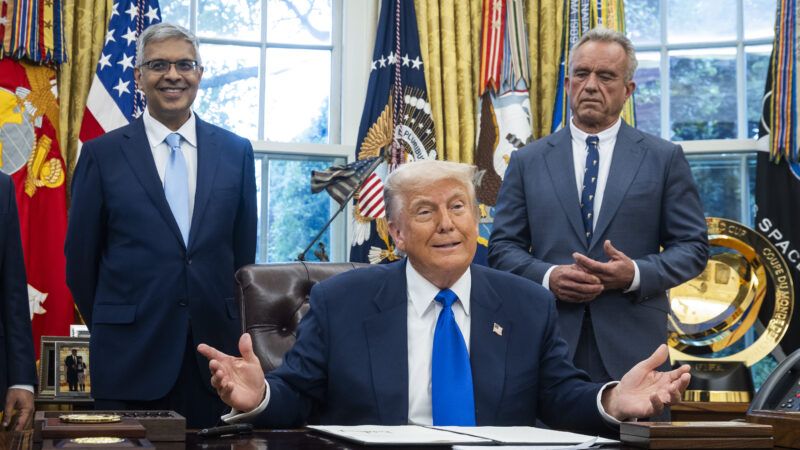Is Donald Trump To Blame for a COVID Lab Leak?
Criticisms of the president's alleged flip-flopping on gain-of-function research funding miss some key context.

If COVID-19 leaked from a Chinese lab as a result of U.S.-funded gain-of-function research, is Donald Trump to blame?
The New York Times opinion writer David Wallace-Wells seems to imply the answer is yes in his latest column.
Wallace writes:
It was under the Trump administration in 2017 when the National Institutes of Health lifted an Obama-era pause on gain-of-function funding in what may have looked at the time like an inside-baseball argument among scientists but now looks more like a strike against liberal safetyism, which reopened the door to the kinds of research the American right now reflexively blames for the pandemic.
Writer Richard Hanania made a similar point in a recent essay on the right's stolen valor on gain-of-function skepticism, saying that, "In fact, it was the Obama administration that paused funding for high-risk [gain-of-function] studies in 2014. The ban was lifted by none other than Donald Trump in 2017."
Both writers are trivially correct that the Obama administration implemented a pause on gain-of-function research and the first Trump administration lifted it.
Yet both writers' implied point—that Trump's newfound hawkishness on gain-of-function research is belated and hypocritical—misses a few key facts.
Firstly, the Trump administration's lifting of the Obama administration's pause was a continuation, not a break, of its predecessor's policies. Secondly, and more importantly, federally funded gain-of-function research continued unhampered under both the Obama and Trump administrations' policies.
Understanding both points is important for grasping why past efforts to more closely vet gain-of-function research failed in a possibly catastrophic way.
To start, the Obama administration's pause on gain-of-function research funding was, as the name would suggest, always intended as a temporary measure. Its explicit purpose was to give policymakers time to develop a more permanent regulatory framework.
The White House's 2014 announcement of the pause explicitly says that the U.S. government "will undertake a deliberative process to assess the risks and benefits of certain gain-of-function (GOF) experiments."
"The funding pause will end when the U.S. government has adopted a Federal policy regarding gain-of-function studies on the basis of the deliberative process described above, which is expected to occur 2015," it continues.
So, again, the pause was always intended to be temporary. It was also scheduled to end during the Obama administration.
As it turned out, the "deliberative process" for creating a regulatory framework for gain-of-function research took longer than expected.
It wasn't until December 2017 that the pause was replaced with the so-called P3CO framework—a policy requiring funding proposals for research with the potential to create pandemic pathogens to be reviewed by a department-level panel in the Department of Health and Human Services (HHS).
So, while the Trump administration did lift the pause in favor of a seemingly more permissive policy, that was always the plan. The Trump White House was not departing from its predecessor's policy but rather faithfully completing it.
It had nothing to do with the first Trump administration's assault on "liberal safetyism," as Wallace-Wells describes it.
The more substantive issue that Wallace-Wells' and Hanania's summaries elide is that gain-of-function research on pandemic pathogens continued unabated under both the Obama administration's pause and the Trump administration's P3CO framework.
Under both policies, the National Institutes of Health (NIH), through its subsidiary the National Institute for Allergy and Infectious Diseases (NIAID), continued to release funding for such research.
Critics argue that both policies were practically nullified by Francis Collins and Anthony Fauci, the longtime heads of NIH and NIAID respectively, who were fierce advocates for gain-of-function research and sharply critical of restrictions on it.
Since the Obama administration's pause and the Trump-implemented P3CO framework left NIH and NIAID with a lot of effective discretion to decide what research was subject to these policies' restrictions, both were able to continue funding research that should have rightly been stopped.
Lab leak proponents argue that this continued funding, specifically of gain-of-function research performed by the nonprofit EcoHealth Alliance at the Wuhan Institute of Virology, contributed to the creation of the pandemic virus there.
One can then argue that Trump was the president, the buck stopped with him, and therefore, he's ultimately responsible for NIH research funding decisions made on his watch.
But it's not true that the first Trump administration's lifting of the gain-of-function research funding pause enabled the NIH to do anything it wasn't already doing. It was funding gain-of-funding research under the pause, and it continued to do so after it was lifted.
White House–level policy decisions had little bearing on the agency's behavior.
Wallace-Wells and Hanania go on to criticize the right's bluster about the lab leak as opportunistic and partisan. Yet the politicization of heretofore wonky debates about gain-of-function research appears to actually be resulting in substantive change.
It's that politicization that's prompted President Donald Trump to implement a new, aggressive pause on gain-of-function research funding.
He's also appointed as NIH Director Jay Bhattacharya, a veteran critic of COVID-era policy orthodoxy and a firm lab leak believer, to implement that pause.
He's likely to do a more faithful job of it than his predecessor.
Rent Free is a weekly newsletter from Christian Britschgi on urbanism and the fight for less regulation, more housing, more property rights, and more freedom in America's cities.


Show Comments (66)